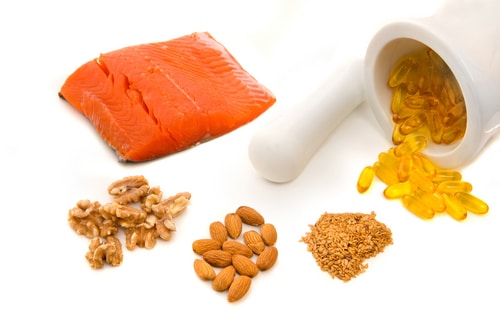
Not getting adequate amounts of these essential fatty acids through diet can lead to a variety of health problems including skin conditions like dermatitis, poor wound healing, decreased immunity against infection and depression. Essential fatty acids are needed to make chemicals called prostaglandins that regulate bodily functions like blood pressure and kidney function and for keeping cell membranes fluid. They’re also involved in nervous system function. As it turns out, most people get too much of one type of fatty acid and not enough of the other.
Omega-3 Fatty Acids versus Omega-6 Fatty Acids
Your body uses the essential fatty acid alpha-linolenic-acid, a type of short-chain omega-3 fatty acid, to make longer chain omega-3 fatty acids, the most important being EPA and DHA. These long-chain omega-3 fatty acids reduce inflammation in the body and may lower the risk of heart attacks and stroke by keeping platelets from clumping together to form blood clots.
Unfortunately, the conversion of the essential omega-3 fatty acid alpha-linolenic acid to long-chain omega-3 fatty acids (DHA and EPA) is not very efficient. That’s why it’s important to get a certain amount of long-chain omega-3s directly from food sources that contain them such as fatty fish. Good dietary sources of alpha-linolenic acid are walnuts, flaxseed, chia seeds, pumpkin seeds, soybeans, and hemp.
The other essential fatty acid, linoleic acid, is a short chain-fatty acid your body uses to make two long-chain fatty acids called arachidonic acid and gamma-linolenic acid. These are referred to as omega-6 fatty acids. For health, it’s important to get a healthy balance of omega-3 to omega-6 fatty acids through diet. Unfortunately, most people get far more omega-6 fats in their diet than they do omega-3s. An ideal ratio of omega-6 to omega-3 fatty acids would be about 2 to 1. In reality, most people consume a ratio of omega-6 to omega-3 fats of about 15 to 1. That’s because omega-6s are so abundant in processed foods and the oils they contain like soybean oil, corn oil, and safflower oil. Many health experts believe this creates an unhealthy fatty acid balance that contributes to inflammation and an increased risk of inflammatory disorders such as cancer, heart disease, arthritis and type 2-diabetes.
What Does This Mean?
A certain amount of fat in your diet is necessary to supply two essential fatty acids your body can’t make – alpha-linolenic acid, a type of omega-3 fatty acid, and linoleic acid, an omega-6 fatty acid. These essential fatty acids serve as building blocks to make other omega-3 and omega-6 fatty acids. Most people who eat a Western diet have a ratio of omega-6 to omega-3 fats that’s too high. The best way to restore a healthy balance is to eat more foods rich in long-chain omega-3s like fatty fish and the short-chain omega-3 fatty acid, alpha-linolenic acid, like flaxseeds and walnuts. This helps to reduce inflammation that increases the risk of other health problems. The take-home message? Eliminate processed foods and include more nuts, seeds and fatty fish in your diet for better health.
References:
Biomed Pharmacother. 2002 Oct;56(8):365-79.
University of Maryland Medical Center “Omega-3 Fatty Acids”
Related Articles By Cathe:
What Are Essential Fatty Acids and Why Is It Important to Keep Them Balanced?
3 Ways an Omega-6 to Omega-3 Imbalance Causes Inflammation and Disease

